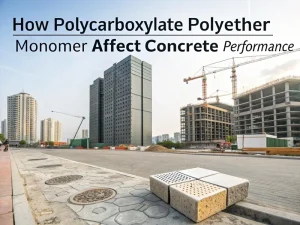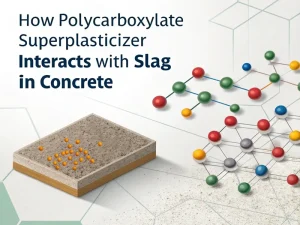Blog
In modern architecture, mineral admixtures have become indispensable in concrete formulations. These materials are derived from natural or industrial byproducts and added to concrete to improve performance, enhance durability, and contribute to sustainable building practices.
By utilizing the unique characteristics of different mineral admixtures, engineers and construction professionals can customize concrete to meet the specific requirements of various projects. This article delves into types of mineral admixtures, their properties, and their applications in the construction industry.

Source: By products of coal-fired power plants.
Composition: The chemical composition of fly ash is mainly composed of silicon dioxide (SiO2), aluminum oxide (Al2O3), and iron oxide (Fe2O3).
Type: According to the source and combustion conditions of coal, fly ash can be divided into two main types: Class F and Class C.
Class F fly ash comes from bituminous or anthracite coal, with a low calcium (CaO) content (usually less than 10%). It is rich in glassy silica and alumina, contributing to its volcanic ash properties.
Class C fly ash is obtained from lignite or sub-bituminous coal, containing a high amount of calcium (usually over 10%) and possessing volcanic ash and hydraulic properties.
Processability: Fly ash, as a fine filler, improves the workability of concrete. It fills the gaps between larger aggregate particles, reducing internal friction within the concrete mixture. This makes concrete more fluid and cohesive, making it easier to pour and complete, especially in complex structures or high-slump concrete.
Durability: fly ash reacts with calcium hydroxide (Ca (OH) _2) produced during cement hydration to form additional calcium silicate hydrate (C-S-H) gel. This process reduces the free Ca (OH) 2 content in concrete, making it more resistant to chemical attacks such as sulfates and chlorides. The permeability of fly ash-modified concrete is also relatively low, improving its durability in harsh environments, including marine and chemical erosion conditions.
Strength development: as time passes, the continuous formation of C-S-H gel leads to a denser and stronger concrete matrix. In some cases, the 28-day strength of fly ash concrete may be slightly lower than that of plain concrete, but in later stages (90 days or longer), it can exceed the strength of plain concrete.
Fly ash is widely used in various construction projects, including high-rise buildings, bridges, dams, and pavements.
In large-scale infrastructure projects such as dams, fly ash concrete can significantly reduce hydration heat and minimize the risk of thermal cracking.
In precast concrete components, fly ash improves surface smoothness and dimensional stability.

Source: A byproduct of iron smelting that rapidly cools to form glassy particles.
Composition: Chemically speaking, slag cement contains calcium silicate, calcium aluminate, and other trace components.
Strength and durability: When mixed with water and cement, slag cement undergoes a hydration reaction similar to cement. It reacts with calcium hydroxide from cement hydration to form additional C-S-H gel and other hydration products. This gives concrete high strength and excellent durability. Slag cement concrete is resistant to sulfate erosion. It is suitable for soils and water with high sulfate content, such as sewer systems and foundations in some geological regions.
Reduce hydration heat: Similar to fly ash, slag cement can reduce the hydration heat of concrete. This characteristic is crucial in pouring large-volume concrete, such as in the construction of thick-walled structures or large-volume concrete foundations, where excessive heat generation can lead to thermal cracking.
Long-term performance: Slag cement concrete has good long-term strength development and resistance to chloride ion penetration. This makes it an ideal choice for structures exposed to de-icing salt, coastal environments, or other chloride-rich conditions, as it can effectively prevent the corrosion of steel bars.
Slag cement is commonly used in marine structures, sewage treatment plants, and industrial flooring. It is also increasingly used in high-performance concrete for buildings and bridges, with long-term durability and strength being key requirements.
Source: Microsilica powder is a byproduct of electric arc furnace production of metallic silicon or ferrosilicon alloys.
Composition: Mainly composed of amorphous silicon dioxide (SiO2) with a purity usually exceeding 90%, it is an excellent powder with a much smaller particle size than cement particles.
Improve density and strength: Fill nanoscale voids (<50 nm) to increase density and compressive strength by 20-40%.
High reactivity: Rapid volcanic ash reaction can reduce bleeding and segregation.
Durability: The dense microstructure of silica fume concrete makes it highly resistant to various forms of degradation. It has extremely low permeability and can effectively prevent the entry of harmful substances such as chlorides, sulfates, and corrosive gases. This makes silicon powder-modified concrete durable in harsh environments, including marine, industrial, and chemical exposure conditions.
Bond strength: Silica fume improves the bond between cement slurry and aggregate, and this enhanced bond strength is beneficial in applications such as shotcrete, as good adhesion is crucial for the structural integrity of shotcrete.
Skyscrapers are made of ultra-high performance concrete (UHPC).
Suitable for wear-resistant pavement, used for repairing concrete pavement structures, as it can improve the bond between new and old concrete.

Source: Kaolin is formed by dehydration at an appropriate temperature (600-900 ℃).
Composition: The main component is anhydrous aluminum silicate.
Volcanic ash reaction: The active components in metakaolin can react with calcium hydroxide produced during cement hydration at room temperature and pressure, producing products such as hydrated calcium silicate and hydrated calcium aluminate, which can significantly improve the strength and durability of cement paste.
Filling effect: The fineness of metakaolin reaches 1250 mesh (particle size of about 10 μ m), which has a good filling effect. Due to its small particles, it can fill the gaps between cement particles, thereby improving the compactness and strength of mortar.
High-performance concrete: As a mineral admixture, it improves concrete’s early strength and durability, reducing alkali-aggregate reaction and penetration.
Geopolymer: Used for preparing high-performance geopolymer materials with excellent physical and chemical properties
Refractory material: As an additive to refractory materials, it improves the fire resistance and stability of the material
Other applications include artificial marble, synthetic molecular sieves, medical rubber fillers, cable fillers, and paint fillers.

Source: Crushed limestone or byproducts from quarries.
Composition: The main component of limestone powder is calcium carbonate.
Dilution effect: Adding a larger proportion of limestone powder will reduce the content of cement clinker and hydration products, increase the free water that reacts with cement particles, and thus improve the hydration degree of cement.
Filling effect: Limestone powder is used as a micro aggregate to fill the small pores in concrete, increasing its compactness, thereby improving its strength and hardness, enhancing the compactness of concrete, and preventing moisture and chemical substances from penetrating the interior of concrete
Chemical effect: Limestone powder can react with silicates in water to produce hardening substances, improving concrete’s durability and corrosion resistance. In addition, the addition of limestone powder can promote the precipitation of hydrated calcium silicate (C-S-H), accelerate cement hydration, reduce cement clinker use, and lower carbon dioxide emissions.
Cost reduction: Used as an admixture, partially replacing cement or fine aggregates, reducing the cost of concrete.
Cement production: Limestone powder can be used as the primary and alternative admixtures in cement production. By mixing limestone powder with other materials, the performance of cement can be improved, and its strength and durability can be enhanced.
Building materials: Limestone powder can produce various building materials, such as gypsum board, lightweight partition board, etc. These materials are lightweight, high-strength, fire-resistant, and widely used in construction.
Source: Recycled broken glass ground to 45-150 µ m3.
Mechanism: Alkali silica reactivity relief: Fine particles inhibit ASR expansion.
Application:Reflective pavement and decorative concrete.
Various types of mineral admixtures have their unique properties and advantages. Active types like fly ash and silica powder can improve strength and durability. In contrast, inert fillers, such as limestone, can optimize cost and processability.
The innovation of composite materials and waste-derived additives further aligns concrete technology with circular economy goals. Whether improving processability, enhancing durability, reducing costs, or promoting sustainability, mineral admixtures have become essential to the construction industry.
We should choose the most suitable mineral admixture for ourselves based on the actual needs of the project.

How Polycarboxylate Polyether Monomer Affect Concrete Performance
Blog How Polycarboxylate

How Polycarboxylate Superplasticizer Interacts With Slag In Concrete
Blog How Polycarboxylate